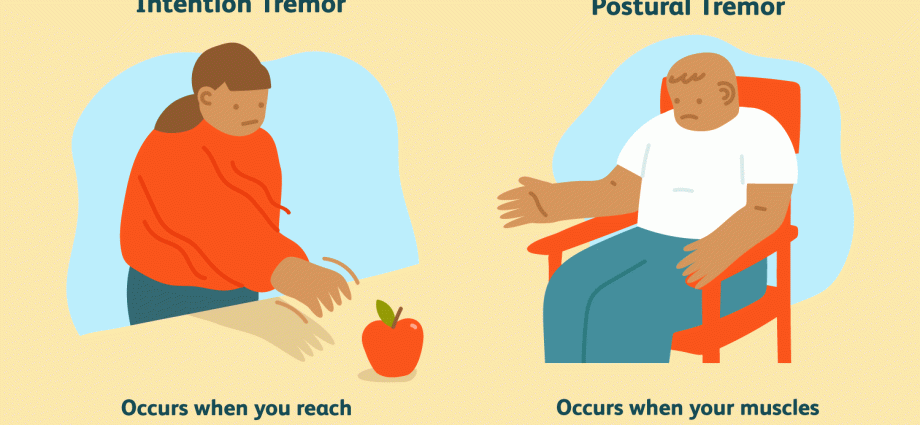Contents
Head tremor (shaking) is a common hyperkinesis that occurs with neurological, endocrine and other diseases, as well as due to exposure to toxins and drugs. Tremor is based on continuous rhythmic oscillatory movements of certain parts of the body (most often the limbs and head) or the entire body.1.
Tremor can occur in any healthy person (physiological tremor). The person himself usually does not feel it, if its amplitude does not increase under the influence of excitement, overwork, hypothermia, excessive consumption of alcohol and caffeine, and other factors.
Pathological tremor differs from the physiological one not only by a higher amplitude of fluctuations, but by a lower, less often – a higher frequency, as well as by the conditions in which it occurs or intensifies.
Causes of head tremor in adults
If the tremor of the hands in most cases can be of a physiological nature (emotional stress, anxiety, fatigue, hypothermia), then the tremor of the head is often associated with some serious illness. According to the etiology, the following types of tremor can be distinguished:
- primary, or essential – appears for no apparent reason;
- secondary (thyrotoxicosis, hyperparathyroidism, hypoglycemia, liver failure, kidney failure, brain neoplasm, traumatic brain injury, stroke, various types of heavy metal salt poisoning, alcohol withdrawal);
- psychogenic;
- medicinal (lithium preparations, valproic acid, neuroleptics, etc.).
- tremor in degenerative diseases of the central nervous system (Parkinson’s disease, hepatolenticular degeneration, multisystem atrophy, spinocerebellar degeneration and idiopathic dystonia, Huntington’s disease, Hunt’s progressive myoclonic ataxia, etc.).
Treatment of head tremor in adults
Treatment for head tremor will depend on the cause of the symptom. Effective and competent treatment can be prescribed only by the attending physician after a series of examinations2.
Depending on the cause or disease causing the head tremor, treatment can be conservative or surgical.
Conservative methods include:
- drug therapy;
- elimination / avoidance of provoking factors;
- psychotherapy;
- physiotherapeutic procedures;
- walking, massage;
- relaxation techniques (breathing exercises, yoga, meditation);
Surgical treatment is aimed at stimulating the deep structures of the brain (high-frequency electrical stimulation of the thalamus nuclei) and can be recommended by the attending physician only after a thorough examination and insufficient effect of conservative therapy3.
Manifestations of head tremor in adults
The characteristic signs of head tremor in adults are:
- shaking head (especially in combination with trembling in the limbs);
- when trying to control the condition or when moving, the tremor only intensifies;
- signs of the disease are not observed in the state of sleep;
- trembling of the chin, uncontrolled facial expressions, wiggling of the tongue;
Diagnostics
The appearance of a tremor is already a sufficient and pronounced symptom. The task of the doctor is to correctly diagnose the root cause. To do this, there are several methods of modern diagnostics.
- Laboratory research. In this case, the doctor may prescribe the following tests: complete blood count, biochemical blood test, liver tests, kidney tests, hormone analysis, copper and ceruloplasmin concentrations, and cerebrospinal fluid tests.
- Magnetic resonance imaging (MRI). This method allows you to detect focal lesions to establish their localization and distribution. If necessary, positron emission tomography – computed tomography (PET-CT) can be prescribed.
- Electromyography (EMG) makes it possible to record a tremorogram with the subsequent assessment of all characteristics of the trembling.
In addition, the attending physician may prescribe additional studies (for example, genetic research methods).
Prevention of head tremor in adults
To prevent brain tremor, you should reduce the number of stressful situations, minimize emotional overstrain. If you want to reduce the risk of tremors, you should give up alcohol and reduce the amount of caffeine consumed.
If there is a family history of genetic diseases, do not neglect preventive examinations by a neurologist once a year. Exclude self-medication and taking medications without a doctor’s prescription. Such actions can only harm and aggravate the course of the disease.
Popular questions and answers
Answered popular questions neurologist Nikolay Kotelnikov.
What can cause head tremors at a young age?
Why does head tremor occur in older people?
When to see a doctor for head tremor?
• with any tremor in the limbs, neck, head, which are not associated with physiological manifestations;
• trembling symptoms are more noticeable to you or others (increased range of motion) and longer lasting, even after natural causes;
• tremor symptoms do not resolve with rest
Sources:
- Govorova T. G., Tappakhov A. A., Popova T. E., Antipina U. D. Tremor: classification, clinical characteristics // Consilium Medicum. 2018. No. 9. https://cyberleninka.ru/article/n/tremor-klassifikatsiya-klinicheskaya-harakteristika
- Volkman J. Stimulation of the deep structures of the brain in essential tremor // TMJ. 2008. No. 1 (31). https://cyberleninka.ru/article/n/stimulyatsiya-glubinnyh-struktur-golovnogo-mozga-pri-essentialnom-tremore
- Tyurnikov V. M., Fedotova E. Yu., Ivanova E. O., Gushcha A. O., Illarioshkin S. N. Surgical treatment of essential tremor: chronic electrical brain stimulation with bilateral implantation of electrodes in the ventral intermediate nucleus of the thalamus // Nervous diseases. 2013. №3. https://cyberleninka.ru/article/n/hirurgicheskoe-lechenie-essentsialnogo-tremora-hronicheskaya-elektrostimulyatsiya-mozga-s-dvustoronney-implantatsiey-elektrodov-v










